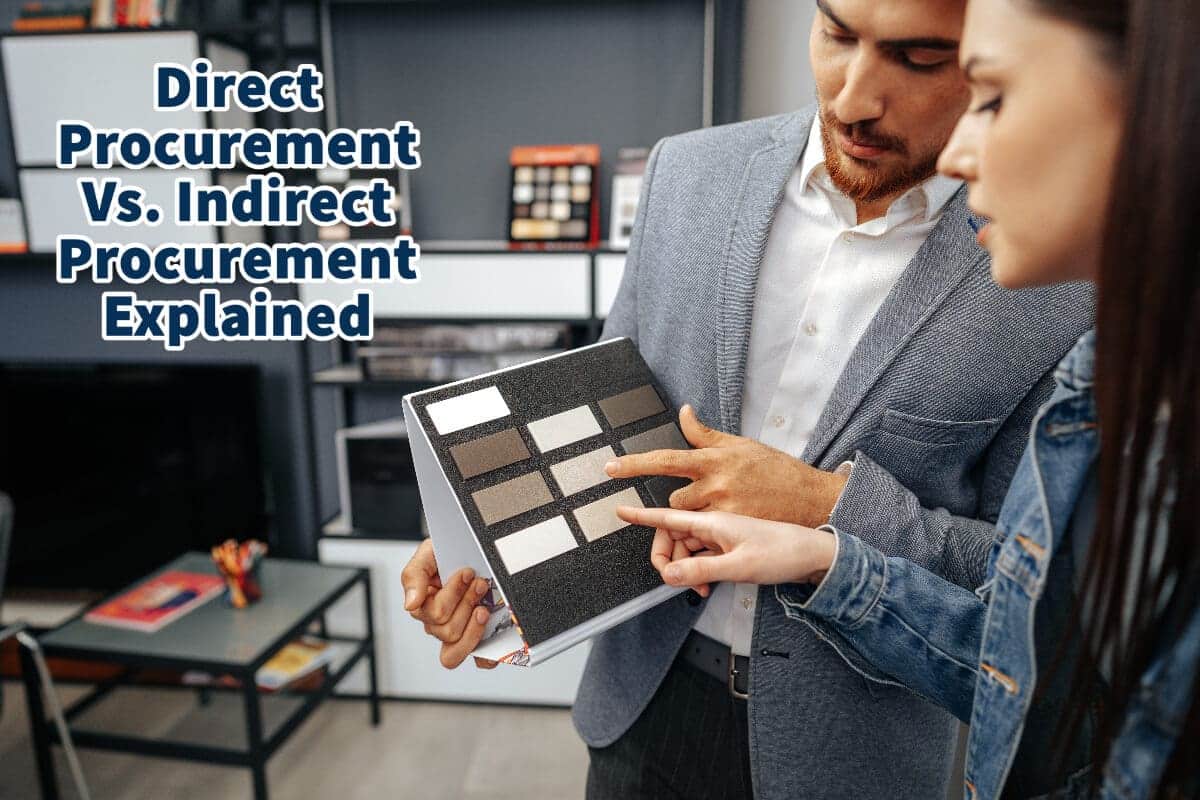When you are involved in the global supply chain, it is good to understand some of the different procurement terms used.
Direct and indirect procurement as two aspects of the procurement process. Direct procurement is something that a company needs to purchase to help them manufacture goods that they sell to their customers. An indirect procurement is a purchase of goods and services that are not essential for manufacturing but as important for the company’s operations.
Table of Contents
Procurement – Direct Procurement Vs. Indirect Procurement
Procurement to many may seem simple – you purchase all the supplies an organization needs to function daily. When procurement is done correctly, it is a pretty complicated and complex process.
Procurement is about the needs that an organization has. But more than just purchasing a product or buying materials, procurement in the supply chain also involves invoice processing, vendor relationships, payment processing, quality control, and shipping.
Procurement has everything to do with ensuring you get the right products or materials at the price, quality, and quantity that an organization needs to continue its business operations.
An important aspect of procurement is understanding the differences between direct and indirect procurement and how each fits into the procurement process.
What Is Direct Procurement?
Direct procurement is acquiring products, supplies, goods, and even services that a company or organization needs for its core business activities. Direct procurement is what you need to buy to service your customers.

As Investopedia explains about direct procurement:
Direct Procurement: This kind of procurement involves any goods and services used during the production process. This includes raw materials, machinery, and other components.
Investopedia
Direct procurement is about purchasing goods and services that directly affect a company’s ability to produce goods or give a service to its clients. It is a core aspect of the business operation.

Some examples of direct procurement would include:
- A manufacturer buys lumber to process the wood into furniture.
- Manufacturers purchase raw materials to produce resin products.
- A mattress manufacturer buys the raw materials needed to make foam mattresses.
- A ceramic producer buys the clay raw materials to make their ceramics.
- New machinery to help you produce a product quicker than before.
- A sofa manufacturer buys fabric for a customer to make a sofa or chair.
Direct procurement is everything that a company will purchase to supply a finished product to its customers. It is all the essential things a company needs to be able to service and provide its customers.
Direct procurement usually has something to do with manufacturing or buying supplies to help serve a client. For example, a construction company may purchase wood flooring to install a new floor for a client, or a painter may purchase paint to paint a house for a customer; all of these would also be direct procurement.
What Is Indirect Procurement?
Indirect procurement is also about products and services that support a company or organization, but purchasing these goods and services does not have an essential role in the business operations,
Indirect procurement can be something like office supplies, stationery, or even Christmas decorations for the office. These products and services are not essential for the company’s operations but help ensure the company functions properly.

Indirect procurement plays a supporting role in the organization or company and does not have an essential role as direct procurement. A company needs the raw materials to manufacture the goods but can do without any Christmas decorations if money is tight or business is challenging.
Investopedia defines indirect procurement as:
“Indirect Procurement: Goods and services purchased under this type of procurement are used to meet the operational needs of a business. As such, they don’t contribute to the company’s revenues. This may include office equipment and supplies, furnishings, and marketing.”
Some examples of indirect procurement purchases would include:
- Computer equipment such as laptops or personal computers.
- Computer programs for the company operations.
- Employee development tools such as a book or even course.
- Office decorations and supplies.
- A company buys office furniture.
- A company invests in a marketing campaign.
Indirect procurement can be as important as direct procurement as it can affect a company’s operations. But if money is tight or business is slow, most companies will start to cut or slow down on indirect procurement instead of direct procurement expenses.
Suppose an employee’s computer system is still working but not the most up-to-date version. In that case, most companies will postpone computer purchasing as they will not consider it as essential as ordering direct procurement goods as raw materials and supplies to continue to produce their products and services for their clients.
Anyone in the global supply chain should understand the difference between direct and indirect procurement. It can help you know what and how to budget for your monetary needs.
Find out more about how Mondoro can help you create, develop, and manufacture excellent home decor and furniture products – don’t hesitate to contact me, Anita. Check out my email by clicking here or become a part of our community and join our newsletter by clicking here.
Mondoro gives out a FREE Lookbook to anyone interested. You can receive a copy of our latest Lookbook by clicking here.
Listen to our Podcast called Global Trade Gal. You can find it on all major podcast platforms. Try out listening to one of our podcasts by clicking here.
Subscribe to our Mondoro Company Limited YouTube Channel filled with great videos and information by clicking here.
Related Content
Supply Chain Differences: Product Sourcing vs. Product Procurement
Product sourcing is obtaining or purchasing a product for your supply chain needs. Product procurement is the process put in place for the entire product, such as sourcing, purchasing, and delivery of the product.
You can discover more by reading Supply Chain Differences: Product Sourcing vs. Product Procurement by clicking here.
6 Common Product Procurement Or Sourcing Errors, What You Need To Know
Product procurement or sourcing is an essential part of any supply chain management. Some joint product procurement or sourcing errors include 1) not fully understanding the product they are procuring or sourcing or 2) not understanding the actual product or quality requirements, 3) not properly vetting the vendor, 4) the wrong vendor, and 5) misunderstanding the vendor’s capabilities.
You can read our blog on 6 Common Product Procurement Or Sourcing Errors, What You Need To Know by clicking here.
5 Common Product Sourcing or Product Procurement Errors
It cannot be easy to source new suppliers and new products. Mondoro has sourced many products in many countries throughout our many years in operation. And with that product sourcing, we have also learned a lot of costly, complicated, and complex lessons.
You can learn more by reading our blog, 5 Common Product Sourcing or Product Procurement Errors, by clicking here.

